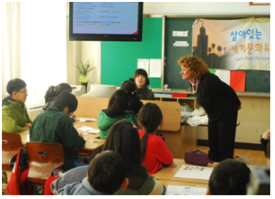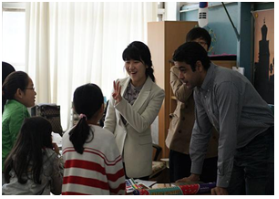When I went to the supermarket near my neighborhood in Tenafly, I was browsing for green tea, preferably Japanese-made. However, when I arrived at the store, I noticed that green tea bags from Japan were all empty. Emily Sheen, the store manager of the supermarket, told me that all consumable products from Japan were suspended from purchase.

Many Japanese Stores have been hit hard by the recent Fukushima Disaster.
Fear of radiation expands throughout the United States

Korean Stores in LA experience revenue after the Fukushima plant crisis (following picture from http://www.hmart.com/company_new/shop_main.asp)
However, for the Korean store in LA, they were experiencing an increase in revenue. Many Korean and Chinese stores, state the store manager of the LA Korean market, were experiencing increasing revenue and customers that went to Japanese stores. Seaweed and Korean seaweed soup (미역국) are currently popular item currently in California, because of its taste and its high content in iodine. Although the store manager expressed sympathy for the Japanese store owners, he said he was glad that he was facing less fierce competition from other stores.

UCLA Student: “Because the wind will head toward the US, in the Western direction, we may see a significant increase in radiation.” (Picture from http://www.ucla.edu/academics.html)
The situation may not be as frightening as people imagine, but the discomfort still remains
I also interviewed a graduate student in UCLA (he asked to be anonymous), who is currently studying meteorology and nuclear physics. “Unlike the opinions stated in the media, the US will be not affected by the radiation as much.” He also stated that he was not worried about the radiation coming towards California. “Less than 100 milisieverts will reach California, and not at all beyond the Rocky Mountains, so there shouldn’t be panic am I seeing now in LA.” However, he stated that there could be a great number of factors on how the situation could get serious. “If the reactors are not contained, not cooled, or not repaired quickly, we will see a great amount or radiation in the globe,” he said. He also stated that if the meltdown and the subsequent explosion were serious enough, there could be potential global fallout around the Pacific Area. “Because the wind will head toward the US, in the Western direction, we may see a significant increase in radiation.” When I asked if Korea will be faced with radiation from the plants, he said no. “Wind should blow to the West, so there is no chance that Korea will face radiation from the wind. If there was to be radiation contamination from Korea, it may come from the contaminated seawater used to cool the reactors.”
The US has reasons to worry. Even though many efforts have been extended to curb the problem, including sending 180 workers to fix the reactors, so far none of the plans has succeeded. The US will face a shortage of needed Japanese goods, as Japanese agricultural produce is currently restricted in the US and electronics cannot be resupplied as Japanese factories are now shut down. The US has also faced a nuclear crisis of its own, the Three Mile Island incident in the 1970s. “Although it hasn’t been as serious as the Fukushima plant disaster,” recounts the sushi chef in New York, “we couldn’t sell produce from Pennsylvania for months.”Although Japan is a faraway nation from the United States, its tragedy has greatly affected its faraway neighbor.
'청소년 기자단' 카테고리의 다른 글
| 길 잃은 소녀들 (3) | 2011.03.31 |
|---|---|
| Great Culture, Okay Food, but So So Shopping (1) | 2011.03.30 |
| Dreaming of Becoming the Next New Global Leader! (0) | 2011.03.27 |
| Korean Sheep in American Streets (0) | 2011.03.17 |
| 4천 년의 세월 거슬러 입 안으로 ‘쏙’ 들어간 중화 한 입! (2) | 2011.03.15 |



































